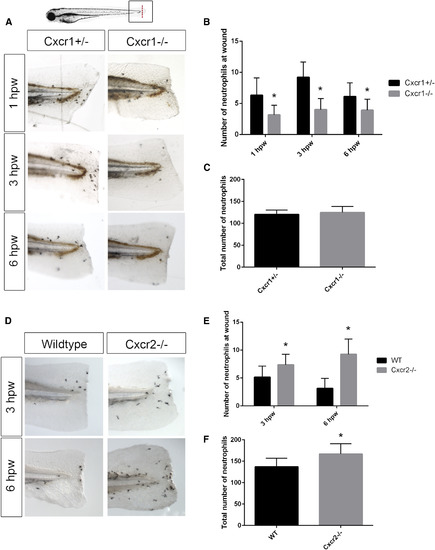Fig. 1
- ID
- ZDB-FIG-180907-5
- Publication
- Powell et al., 2017 - Chemokine Signaling and the Regulation of Bidirectional Leukocyte Migration in Interstitial Tissues
- Other Figures
- All Figure Page
- Back to All Figure Page
|
Cxcr1 Is Required for Neutrophil Recruitment to Tissue Wounds, whereas Cxcr2 Is Required for Neutrophil Resolution (A) Sudan black staining of 3 days post-fertilization (dpf) larvae at 1, 3, and 6 hr post-wound (hpw) reveals Cxcr1?/? larvae recruit less neutrophils to tail-transection compared to Cxcr1+/? control. (B) Quantification of neutrophils caudal to the notochord (n = 16 heterozygote [het] and 19 mutant larvae [1 hpw], 18 het and 18 mutant [3 hpw], and 25 het and 21 mutant [6 hpw]). (C) Quantification of total neutrophils in 3 dpf Cxcr1+/? and Cxcr1?/? larvae (n = 19 het and 23 mutant). (D) Sudan black staining of 3 dpf larvae at 3 and 6 hpw show more neutrophils at the wound microenvironment in Cxcr2?/? embryos than WT. (E) Quantification of neutrophils caudal to the notochord in Cxcr2?/? and WT (n = 70 WT and 46 mutant [3 hpw] and 83 WT and 54 mutant [6 hpw]). (F) Total neutrophil number is higher in Cxcr2?/? than WT (n = 48 WT and 40 mutant larvae). Error bars represent SE. ?p < 0.05. |
| Fish: | |
|---|---|
| Condition: | |
| Observed In: | |
| Stage: | Protruding-mouth |

